Now that you understand the basic idea of spread betting, you are probably eager to learn the details. There are perhaps a dozen companies that you could go to, and you can look at independent assessments of how good they are. There is more about how to pick a spread betting company later, and for the moment we’ll just use Capital Spreads to explain the process.
Placing a Bet Online
Here’s a typical opening screen which shows popular trades.
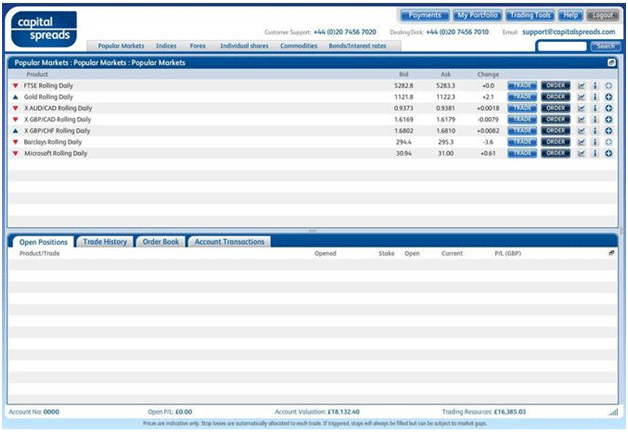
You can see that the popular trades include the FTSE Index, the price of gold, a few Forex pairs, and a couple of shares. On the bottom of the screen is your order book, empty at the moment because there are no open orders. The first step in spread betting is to get the two prices, the buy and sell prices (Bid and Ask in the above screen), for the trade you are interested in.
Each of the popular trades shows the Bid and Ask figures, and has a trade and order button. We’ll talk about the order button later, but for now we just want to enter a bet, so we can use the trade button. If the trade is showing, that’s easy; if it’s not, then in this case there are dropdown menus to find the trade, or you can enter the name and search.
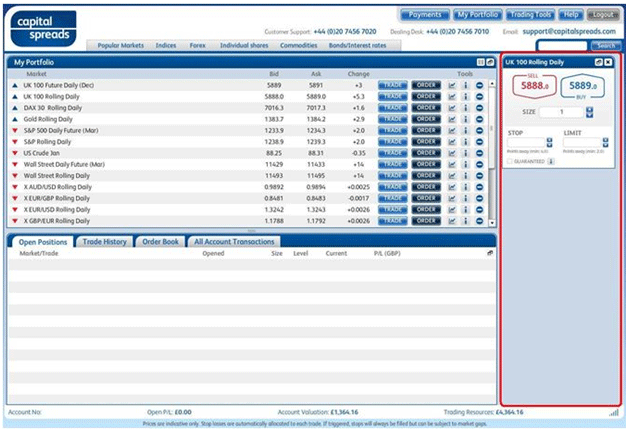
For this example we’ve picked the UK 100 Rolling Daily, and a trading window opens when you click on the trade button. This shows you can sell at 5888.0, and buy at 5889.0, exactly the same as in the list.
Note a couple of things – the spread or difference between the bid and ask or sell and buy prices is 1.0. In this case the sell icon is drawn like a down arrow, and the buy icon is an up arrow – this reminds you to sell if you think the price is going down or buy if you think it’s going up. The bet size box is automatically filled out at 1, but can be changed so you can bet what you want to.
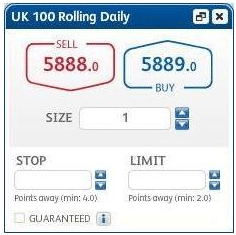
The stop, limit and guaranteed items we’ll explain shortly. If you think the price is going up, you buy – this is also called “going long” or an “up bet”; if you think it’s going down, you sell – this can be called “going short” or a “down bet”. If you get it right, you make a profit. How you can get it right is something that we’ll go into later. Nobody gets it right all the time (sorry to disappoint you), but you can and should put the odds in your favour, and to do so you have to learn some basic things about trading and psychology.
When you have gone through whatever process you choose to decide which way to bet, you should finally check the size of the bet and change it if you need to, before clicking to place the bet online. What makes spread betting different from many other forms of trading is that there is no set amount you bet, although there is usually a minimum of 50p or £1. You get to choose how much you want to bet for each point of movement in the price, no matter which market you are trading. You won’t always bet the same amount, you need to figure out what works for your account and your expectation of the trade. This we also go into later. Please don’t be tempted to try some bets before you learn all about it – unless you are just using a free demo account and getting used to the interface.
Note that in this case we have the “Rolling Daily” for the spread bet. That means that it expires today, but will be rolled over to tomorrow by the bookmaker. Back on the original favourites screen, you may remember there was also a choice of “UK 100 Future Daily (Dec)”. As you might expect, this is the other type of bet which we mentioned, and it will expire on a future date in December. You can see that the spread is larger, which allows for more variability over the extended time.
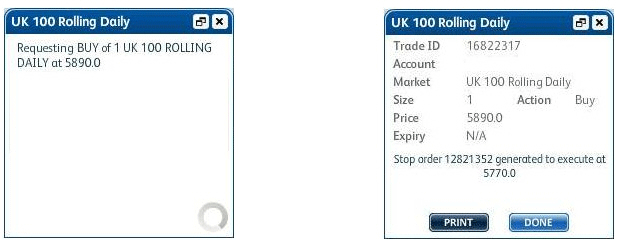
Here, on the left, is the pending dialogue box, and on the right is the order confirmation which happens almost immediately. You will usually get an e-mail confirmation as well. You have to understand that what you have done is bet on the price movement. With spread betting, you never own shares or whatever else you are betting on – that’s why you don’t have to pay tax or stamp duty.
You can see that a “stop order” has been automatically generated, according to the order confirmation. Many spread betting providers have this facility, to save you having to enter a stop order separately every time you bet. We will see what a stop order is in detail in the next chapter, and also look at other types of order – for now, you only need to know that it is meant to stem any losses in your trade should it go in the wrong direction, although it has some limitations as you will discover.
Closing a Bet
So far, we have looked at the mechanics of making a bet. But what happens when you decide to close your position, and cash out the bet?
Closing the bet can be as easy or easier than making the bet in the first place. Fundamentally, what you are doing is placing the opposite bet, that is if you “bought” you now “sell” for the same amount per point, or if you “sold” you now “buy”. So closing happens at the other end of the price spread – as previously mentioned that is the dealer’s margin.
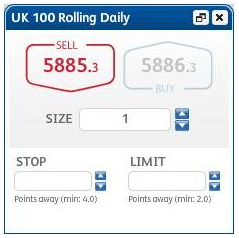
The spread betting dealer will usually try to make it as easy and obvious as he can, to avoid having silly errors and having to sort them out. Sometimes there will be a close button on the trade screen next to the trade, and that will take you straight to the required order. You can see from this dialogue box, again sticking with Capital Spreads for consistency, but others are similar, that it only gives you the option to “sell” because you already “bought” into this trade.